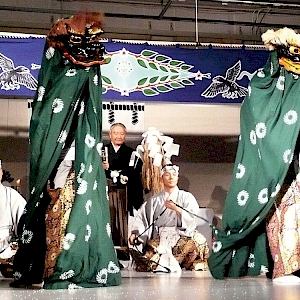Aomori Folklore/Performing Arts

The Program
Hyakumanben/Juzu Mawashi (One Hundred Times/ Prayer Beads Pass-Along)
The women elders pass along a huge string of prayer beads while repeating Nenbutsu (chanting the name of Buddha) in front of the Hyakumanben stone tower on the outskirts of town, praying to prevent sickness from entering the village. The women will relive on stage their traditional observance, a practice rarely seen today in urban villages.
Butoh and Tsugaru-jamisen Collaboration
Tsugaru-jamisen was originally an instrument played accompanying Min'yō (folk song). Bosama (Blind men) used to walk from door to door playing the instrument to earn a living. Such solo performances later became more sophisticated and today Tsugaru-jamisen players could be found all over Japan.Appearing on stage is the master of the Takeyama school, Chikushun Takahashi, who has succeeded the name of Takahashi from Chikuzen Takahashi (founder of the Takeyama school), who was disciple to Chikuzan Takahashi, the great star in the history of Tsugaru-jamisen.
The butoh dancer in collaboration, Shoichi Fukushi, is an Aomori local. He had explored the concept of Butoh in relation to folk tradition and the local culture through Hoito (Beggar) performances for over 40 years.
Shimokita Noh Dance (Gongen dance)
One of the “Important Intangible Folk Cultural Properties” of Japan. The dance is said to have derived from the Yamabushi Kagura. Yamabushi (mountain monks) introduced this to the Shimokita peninsula.
The Gongen dance is the most important of Noh dance, performed to purify the village to protect its safety and the health of its people.
Date
Saturday 29 August 2015, 17:30 - 18:30
Venue
Aomori Museum of Art, Theatre
Audience
Open to anyone
Date
Saturday 29 August 2015, 17:30 - 18:30
Venue
Aomori Museum of Art, Theatre
Audience
Open to anyone
Booking
Booking required
Lecturer/Performer
Hyakumanben: Ladies from the Oyasawa village of Aomori city
Tsugaru-jamisen: Chikushun TAKAHASHI Butoh: Shoichi FUKUSHI
Noh Dance (Gongen dance): Higashidoori village Gamanosawa Youth Association
Enquiries and bookings
Keio University Art Center
Organiser(s)
Keio University Art Center
プログラム解説
百万遍/数珠回し
春秋の彼岸の一週間、各集落では老女達がムラ外れの百万遍の石塔の前で大きな数珠を回しながら念仏を唱えて、ムラに疫病が入ってこないようにと祈るものである。
この行事は、『日本民俗事典』(昭和42年2月 大塚民俗学会編 弘文堂)によると、次のように記されており、今回の数珠回しもこの中の略法草修が広く各地に伝えられ現在まで残されたものであると考えられる。
ひゃくまんべん (百万遍) 百万念仏の略。『百万遍念仏縁起』によると、弘化元年(1844)の大地震後に疫病が流行し、浄土宗本山京都知恩寺八世の善阿上人が勅命を奉じて念仏百万遍を唱えたところ、貢献があり、後醍醐天皇から百万遍の寺号を賜ったことにはじまるという。百万遍念仏に2種あり、一つは如法真修または顆繰といって、1人が7日間または10日間を限って念仏を一百万遍となえることをいう。二つは略法草修または早繰(ざらざらぐり)といって、多数の人々が1080顆はたはその倍数の百万遍念珠をくり、1顆をくるごとに念仏を唱えてその総和をもって一百万遍にするもので、実際には念仏の総計が10万遍でも百万遍といい、先亡追善・報恩感謝・虫送り・雨乞いや疫病退散・無病息災の祈祷として民間に広く行われている。
津軽三味線
ボサマと言われた目の悪い男性が生業のため三味線を持って唄を歌いながら門付けをして歩いていたものが、産土様(集落の神社)の祭礼の際の余興としての民謡大会や、北海道へので出稼ぎ先のニシン場やヤマゴ(樵)の飯場へ津軽民謡の一座を組んで歩くようになり、唄の伴奏であった三味線の前弾き(前奏)がそれぞれの弾き手によってアレンジされそのテクニックが競われるようになり、その前奏(曲弾き)が独自の音楽として津軽三味線と呼ばれるようになったのである。その中でも高橋竹山は津軽三味線を内外に広めた第一人者であり、第2次世界大戦後、津軽民謡の歌手兼興行も手がけた成田雲竹と一座を組み各地で興行したり、ラジオに出演するなど、津軽民謡の普及に努めた。現在では日本各地に津軽三味線の演奏者がいる。
蒲野沢の能舞
東北各地には、中世以降に修験山伏が伝えたと言われる山伏神楽が各地に伝えられている。青森県東通村を中心として下北半島に伝えられている能舞もこの一つである。
修験山伏が信奉する熊野権現の化身である権現様(獅子頭)を採り物として舞う権現舞(獅子舞ともいう)や、日本の中世から寺社で行われた場を清める為に舞われる式舞、歌舞伎や地芝居の影響を受けたと考えられる武士舞、狂言等から発生したどげ舞(道化舞)等日本の芸能史を考える上でも貴重な民俗芸能を伝えている。
この能舞は、下北地方の各集落で正月を中心に舞われるが、その担い手は学校卒業後から数え42歳(現在は人口減少のため45歳以上になっている)までの青年達であり、12月から始まるウチナライ(練習)から1月の幕納めまでは、肉を一切口にしないなどの厳しい決まりもあり、芸能の伝承以外に成人教育の場としての機能も備えていると考えられる。今回、演じる権現舞は能舞の中で一番重要なもので、人々の健康や家々・集落の安全等災厄を祓うものであり、幕開き、幕納め、正月の門打ち、新築の家の屋固めなどの際に行われる。
What's on
- Introduction to Art Archive XXVIII: In the Shadows: The Obscure World of Tatsumi Hijikata’s Choreography
- Papier Plié 02: Correspondences between Shuzo Takiguchi and Shusaku Arakawa/Madeline Gins — Margin and Blank
- The 40th Anniversary of Hijikata Tatsumi’s Death: Talking together about Hijikata Tatsumi
- Introduction to Art Archive XXIX: Yoshio Taniguchi in Keio
- Ambarvalia XV War, Wandering, and Nietzsche: On Nishiwaki and Hagiwara in the 1930s
- KUAC Cinematheque 4: 状況劇場「蛇姫様」上映会—単独性と反復または記録についてII
- 【Inclusive program】Architecture Open Day related workshops "Haptic appreciation workshop──enjoying sculptures"
- Inclusive Movement Workshop ‘Heart’ by Butoh Dancer Saga Kobayashi



